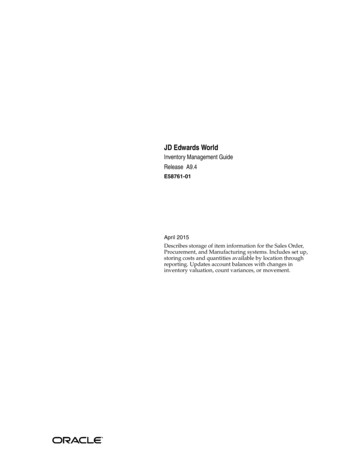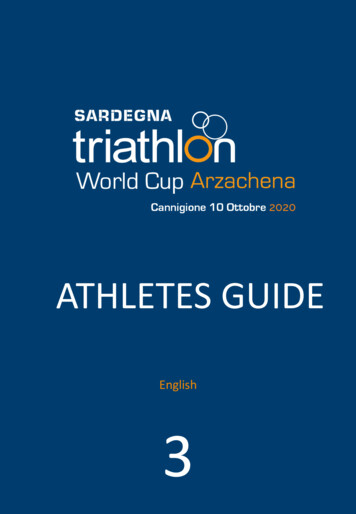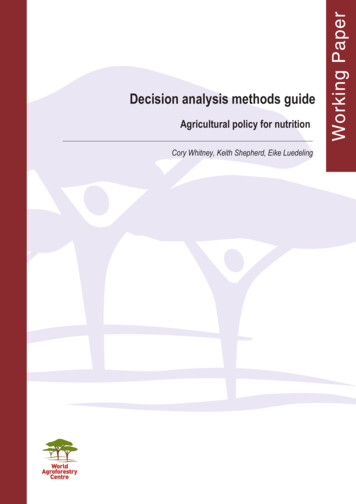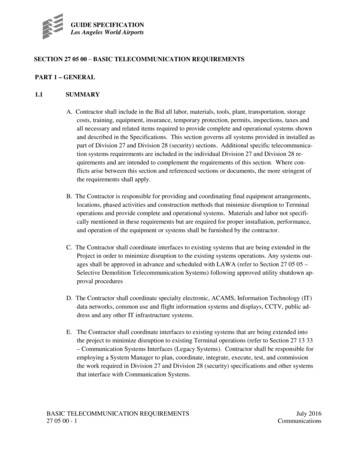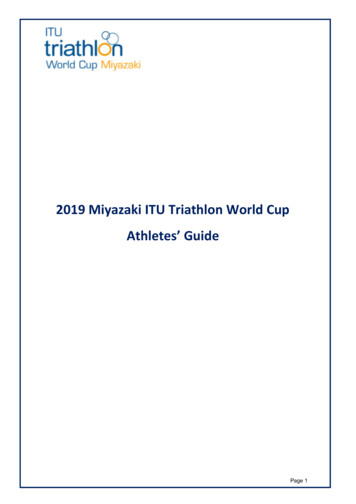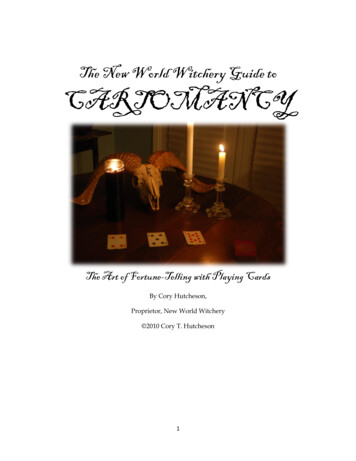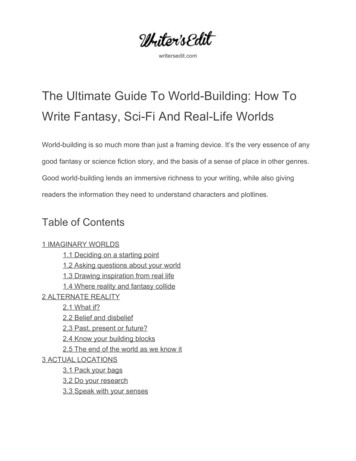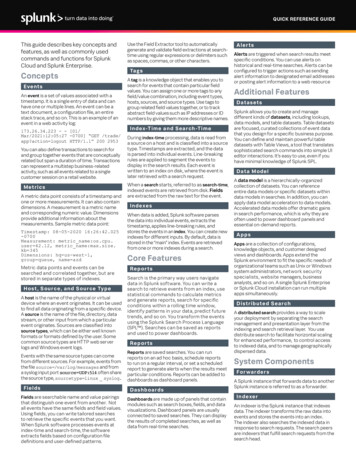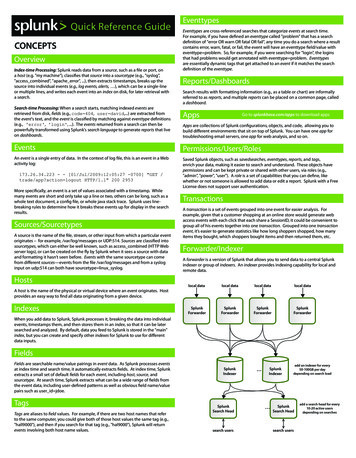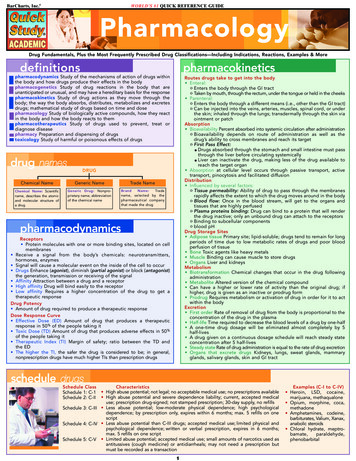
Transcription
BarCharts, Inc. WORLD’S #1 QUICK REFERENCE GUIDEPharmacologyDrug Fundamentals, Plus the Most Frequently Prescribed Drug Classifications—Including Indications, Reactions, Examples & Moredefinitionspharmacokineticspharmacodynamics Study of the mechanisms of action of drugs withinthe body and how drugs produce their effects in the bodypharmacogenetics Study of drug reactions in the body that areunanticipated or unusual, and may have a hereditary basis for the responsepharmacokinetics Study of drug actions as they move through thebody; the way the body absorbs, distributes, metabolizes and excretesdrugs; mathematical study of drugs based on time and dosepharmacology Study of biologically active compounds, how they reactin the body and how the body reacts to thempharmacotherapeutics Study of drugs used to prevent, treat ordiagnose diseasepharmacy Preparation and dispensing of drugstoxicology Study of harmful or poisonous effects of drugsdrug namesRoutes drugs take to get into the body Enteral:o Enters the body through the GI tracto Taken by mouth, through the rectum, under the tongue or held in the cheeks Parenteral:o Enters the body through a different means (i.e., other than the GI tract)o Can be injected into the veins, arteries, muscles, spinal cord, or underthe skin; inhaled through the lungs; transdermally through the skin viaointment or patchAbsorption Bioavailability Percent absorbed into systemic circulation after administrationo Bioavailability depends on route of administration as well as thedrug’s ability to cross membranes and reach its targeto First Pass Effect: Drugs absorbed through the stomach and small intestine must passthrough the liver before circulating systemically Liver can inactivate the drug, making less of the drug available toreach the target organ Absorption at cellular level occurs through passive transport, activetransport, pinocytosis and facilitated diffusionDistribution Influenced by several factors:o Tissue permeability: Ability of drug to pass through the membranesrapidly affects the extent to which the drug moves around in the bodyo Blood flow: Once in the blood stream, will get to the organs andtissues that are highly perfusedo Plasma proteins binding: Drug can bind to a protein that will renderthe drug inactive; only an unbound drug can attach to the receptorso Binding to subcellular componentso blood pHDrug Storage Sites Adipose tissue Primary site; lipid-soluble; drugs tend to remain for longperiods of time due to low metabolic rates of drugs and poor bloodperfusion of tissue Bone Toxic agents like heavy metals Muscle Binding can cause muscle to store drugs Organs Liver and kidneysMetabolism Biotransformation Chemical changes that occur in the drug followingadministration Metabolite Altered version of the chemical compound Can have a higher or lower rate of activity than the original drug; ifhigher, drug is given as an inactive or prodrug form Prodrug Requires metabolism or activation of drug in order for it to actwithin the bodyExcretion First order Rate of removal of drug from the body is proportional to theconcentration of the drug in the plasma Half-life Time required to decrease the blood levels of a drug by one-half A one-time drug dosage will be eliminated almost completely by 5half-lives A drug given on a continuous dosage schedule will reach steady stateconcentration after 5 half-lives Steady state Rate of drug administration is equal to the rate of drug excretion Organs that excrete drugs Kidneys, lungs, sweat glands, mammaryglands, salivary glands, skin and GI tractDRUGChemical NameGeneric NameTrade NameChemical Name: Scientificname, describes the atomicand molecular structure ofa drugGeneric Drug: Nonproprietary name, abbreviationof the chemical nameBrandName:Tradename, selected by thepharmaceutical companythat made the drugpharmacodynamicsReceptors Protein molecules with one or more binding sites, located on cellmembranes Receive a signal from the body’s chemicals: neurotransmitters,hormones, enzymes Signal will cause a molecular event on the inside of the cell to occur Drugs Enhance (agonist), diminish (partial agonist) or block (antagonist)the generation, transmission or receiving of the signal Affinity Attraction between a drug and a receptor High affinity Drug will bind easily to the receptor Low affinity Requires a higher concentration of the drug to get atherapeutic responseDrug Potency Amount of drug required to produce a therapeutic responseDose Response Curve Effective Dose (ED) Amount of drug that produces a therapeuticresponse in 50% of the people taking it Toxic Dose (TD) Amount of drug that produces adverse effects in 50%of the people taking it Therapeutic Index (TI) Margin of safety; ratio between the TD andthe ED The higher the TI, the safer the drug is considered to be; in general,nonprescription drugs have much higher TIs than prescription drugsschedule drugsSchedule ClassSchedule 1: C-1Schedule 2: C-IICharacteristics High abuse potential; not legal; no acceptable medical use; no prescriptions available High abuse potential and severe dependence liability; current, accepted medicaluse; prescription drug-signed; not stamped prescription; 30-day supply, no refillsSchedule 3: C-III Less abuse potential; low-moderate physical dependence; high psychologicaldependence; by prescription only, expires within 6 months; max. 5 refills on onescriptSchedule 4: C-IV Less abuse potential than C-III drugs; accepted medical use; limited physical andpsychological dependence; written or verbal prescription, expires in 6 months;max. 5 refills on one scriptSchedule 5: C-V Limited abuse potential; accepted medical use; small amounts of narcotics used asantitussives (cough medicine) or antidiarrheals; may not need a prescription butmust be recorded as a transaction1Examples (C-I to C-IV) Heroin, LSD, cocaine,marijuana, methaqualone Opium, morphine, coca,methadone Amphetamines, codeine,barbiturates, Valium, Xanax,anabolic steroids Chloral hydrate, meptrobamate,paraldehyde,phenobarbital
Pharmaceutical C lass i f ications Common drug examples: Doxazosin mesylate Cardura Prozosin hydrochloride Minipress Tamsulosin hydrochloride Flomax Terazosin hydrochloride Hytrin Adverse reactions Orthostatic hypotension, headache, palpitations,fatigue, nausea, weakness, dizziness, faintingadrenergicsMimic naturally occurring catecholamines (epinephrine, norepinephrineand dopamine) or stimulate the release of norepinephrineIndications Alpha-adrenergic agonists used to treat hypotension Common drug examples: Norepinephrine Lovophed Pseudoephedrine Cenafed, Dimetapp, Sudafed, Triaminic DM (OTCused to treat other conditions) Adverse reactions: Increased blood pressure, AV block; other effectsinclude: nausea, vomiting, sweating, goose bumps, rebound miosis,difficulty in urinating, headache, dilated pupils, photophobia, burning,stinging and blurry eyesBeta 1 adrenergic agonists Bradycardia, low cardiac output, paroxysmalatrial or nodal tachycardia, ventricular fibrillation, cardiac output Common drug examples: Dobutamine hydrochloride Dobutrex Adverse reactions Tachycardia, palpitations and other arrhythmias,premature and ventricular contractions, tachyarrhythmias andmyocardial necrosisBeta 2 adrenergic agonists Acute and chronic bronchial asthma,emphysema, bronchitis, acute hypersensitive (allergic) reaction to drugs,delays delivery in premature labor, dysmenorrhea Common drug examples: Albuterol sulfate Proventil, Ventolin, Volmax Bitolterol mesylate Tornalate Metaproterenol sulfate Alupent Pirbuterol acetate Maxair Salmeterol xinafoate Serevent Terbutaline Brethine, Bricanyl Adverse reactions Nervousness, tremors, headaches, tachycardia,palpitations, hypertension, nausea, vomiting, coughDopamine Improves blood flow to the kidneys; used in acute renal failure,heart failure and shock Common drug examples: Dopamine hydrochloride Intropin Adverse reactions Headaches, ectopic beats, tachycardia, hypotension, bradycardia, nausea, vomiting, hyperglycemia, asthma attacks,anaphylactic reactionsaminoglycosides Indications: Treat infections resistant to penicillin, septicemia, urinary tractinfections, infections of skin, soft tissue and bone, gram-negativebacillary meningitis Used in combination with other antibiotics to treat staphylococcalinfections, endocarditis, tuberculosis, pelvic inflammatory disease Common drug examples: Amikacin sulfate Amikin Gentamicin sulfate Cidonycin, Gentasol Neomycin sulfate Mycifradin Adverse reactions Systemic ototoxicity and nephrotoxicity, skeletalweakness and respiratory distress; oral meds can cause nausea,vomiting, diarrhea; local injections can cause phlebitis and abscessandrogensTestosterone used to promote maturation of male sex organs anddevelopment of secondary sex characteristics; promotes retention ofcalcium, nitrogen, phosphorus, sodium, and potassium; enhances anabolism Indications Androgen deficiency resulting from testicular failure ordeficiency of pituitary origin, palliative for metastatic breast cancer,postpartum breast engorgement, hereditary angioedema, endometriosis,fibrocystic breast disease Common drug examples: Danazol Cyclomen, Danocrine Fluoxymesterone Halotestin Testosterone Testopel pellets Adverse reactions: Extensions of hormonal actiono Males: Frequent and prolonged erections, bladder irritability,gynecomastiao Females: Clitoral enlargement, deepening of the voice, facial orbody hair growth, unusual hair loss, irregular or absent menses Metabolic reactions Fluid and electrolyte retention, hypercalcemia,decreased blood glucose level, increased serum cholesterol, hepaticdysfunction Contraindicated Men with breast or prostatic cancer or symptomaticprostrate hypertrophy, patients with severe cardiac, renal or hepaticdisease or with undiagnosed genital bleedingadrenocorticoidsGlucocorticoids Regulate carbohydrate, lipid and protein metabolism;block inflammation; regulate body’s immune response Indications Asthma, advance pulmonary tuberculosis, pericarditis,acute and chronic inflammation, adrenal insufficiency, antenatal use inpreterm labor, hypercalcemia, cerebral edema, acute SCI, MS, shock Common drug examples: Betamethasone Beclovent, QVAR, Vanceril Hydrocortisone Cortet, Hycort Methylprednisone Medrol, Meprolone, Metacort Prednisone Apo-prednisone, Deltasone, Meticort, Orasone, Sterapred Triamcinolone Azmacort, Nasacort Adverse reactions Primarily a catabolic effect on muscle, bone,ligament, tendon; suppression of hypothalamic-pituitary-adrenalpathway; Cushingoid syndrome with long-term use; other effectsinclude euphoria, insomnia, psychotic behavior, pseudotumor, mentalchanges, nervousness, restlessness, heart failure, hypertension, edema,acute tendon ruptures, delayed wound healing Withdrawal symptoms if drugs stopped abruptly Fever, myalgias,arthralgias, malaise, nausea, orthostatic hypotension, dizziness,fainting, dyspnea, hypoglycemiaMineralocorticoid Regulates electrolyte homeostasis Indications Adrenal insufficiency, orthostatic hypotension in diabetics Common drug examples Fludocortisone acetate Florinef Adverse reactions Salt and water retention, hypertension, cardiachypertrophy, edema, heart failure, bruising, diaphoresis, urticaria, allergicrash, hypokalemia[Note: All adrenocorticoid drugs have both glucocorticoid and mineralocorticoid properties to some extent]angiotensin-converting e n z y m e i n h i b i t o r s Indications Treat high blood pressure and heart failure Common drug examples: Benazepril hydrochloride Lotensin Captopril Capoten Enalapril maleate Vasotec Fosinopril sodium Monopril Lisinopril Prinvil, Zestril Adverse reactions Persistent dry cough, skin rash, loss of taste,weakness, headaches, palpitations, fatigue, proteinuria, hyperkalemiaangiotensin II r e c e p t o r a n t a g o n i s t sVasodilates arterioles by blocking the effects of angiotensin II, enhancerenal clearance of sodium and water Indications Treatment of high blood pressure Common drug examples: Candesartan cilexetil Atacand Eprosartan mesylate Teveten Irbesartan Avapro Losartan potassium Cozaar Telmisartan Micardis Valsartan Diovan Adverse reactions Dizziness, anxiety, confusion, cough, upperrespiratory infections, myalgia, insomnia, hypotension, visualchanges, GI/GU effectsalpha-adrenergic b l o c k e r santicholinergicsLower blood pressure by dilating peripheral blood vessels, reducingperipheral resistance Indications Raynaud’s disease, acrocyanosis, frostbite, phlebitis, diabeticgangrene, hypertension, benign prostatic hyperplasia Indications: Spastic conditions including Parkinson’s disease, muscle dystonia,muscle rigidity and extra-pyramidal disorders2
Pharmaceutical Classifications (continued) Common drug examples: Amobarbital Amytal Phenobarbital Bellatal, Solfoton Primidone Mysoline Secobarbital sodium Seconal Adverse reactions Drowsiness, lethargy, vertigo, headaches and CNSdepression, hypersensitivity can occur (rash, fever) After hypnosis hangover effect, impaired judgment, mood distortion,rebound insomnia Geriatric patients Confusion Pediatric patients Hyperactivity Prevent nausea and vomiting from motion sickness, adjunctivetreatment for peptic ulcers and other GI disorders, bronchospasms,and GU tract disorders Treat poisoning from certain plants and pesticides Use preoperatively to decrease secretions and block cardiac reflexes Common drug examples: Antiparkinsonians:o Benztropine mesylate: cogentin Belladonna alkaloids:o Scopolamine hydrobromide: IsoptoHyoscine, Scopace Synthetic quaternary anticholinergics:o Glycopyrroltae: Robinul Tertiary synthetic and semisynthetic derivatives:o Dicyclomine hydrochloride: Antispas, A-spas, Dibent, Dilomine,Lomine, Ortyl Adverse reactions Dry mouth, decreased sweating, headache, dilatedpupils, blurred vision, dry skin, urinary hesitancy and urine retention,constipation, palpitations and tachycardia; other peripheral effectsinclude dry mucous membranes, dysphasia, stupor, seizures,hyperthermia, hypertension and increased respiration Toxic doses May cause disorientation, confusion, hallucinations,delusions, anxiety, agitation and restlessnessbenzodiazepinesEnhance/facilitate actions of the gamma-aminobutyric acid (GABA) Indications Seizure disorders, anticonvulsants, anxiety, tension andinsomnia, surgical adjuncts for conscious sedation or amnesia,skeletal muscle spasms or tremors, delirium, schizophrenia as an adjunct,nausea and vomiting induced by chemotherapy, neonatal opiate withdrawal Common drug examples: Alprazolam Alprazolam, Xanax Chlordiazepoxide Libritab Clonazepam Klonopin, Rivotril Clorazepate dipotassium Catapres, Dixarit Diazepam Valium, Zetran Estazolam ProSom Flurazepam Apo-Flurazepam, Dalmane Lorazepam Apo-Lorazepam, Ativan Midazolam Versed Oxazepam Apo-Oxazepam, Serax Temazepam Restoril Triazolam Halcion Adverse reactions Drowsiness and impaired motor function; constipation, diarrhea, vomiting, changes in appetite, urinary alterations,nightmares, hallucinations, insomnia Toxic effects Visual disturbances, short-term memory loss, vertigo,confusion, severe depression, shakiness, slurred speech, staggering,bradycardia, difficulty breathinganticoagulants Indications Prevent clot formation in patients with DVTs and pulmonaryembolism, provide anticoagulation during hemodialysis, prevention ofpostoperative clot formation after surgery, decrease risk of strokes,decrease risk of MI in patients with atherosclerosis Common drug examples: Danaparoid Orgaran Delteparin Fragmin Enoxaparin Lovenox Heparin Heparin Lock Flush, Hep-lock Tinzaparin Innohep Adverse reactions Insomnia, headache, dizziness, confusion, peripheraledema, nausea, constipation, pain, fever, vomiting, joint pain, rashantihistaminesbeta b l o c k e r s Indications Allergies, pruritis, vertigo, nausea and vomiting, sedation,suppression of cough, dyskinesia Common drug examples: Allergies:o Azelastine hydrochloride: Astelin, Optivaro Chlopheniramine maleate: Aller-Chlor, Chlor-Trimeton, Chlor-Tripolono Clemastine fumarate: Tavisto Diphenhydramine hydrochloride: Allergy DM, Benadryl, Diphen,Dormin, Midol PM, Nytol, Sominex, Twiliteo Promethazine hydrochloride: Anergan 50, Phenergan Pruritus:o Cyproheptadine hydrochloride: Periactino Hydroxyzine hydrochloride: Anxanil, Atarax, Multipax, Quiess, Vistacon Vertigo, nausea, vomiting:o Cyclizine hydrochloride: Marezineo Cyclizine lactate: Marezine, Marzineo Dimenhydrinate: Dimetab, Hydrate, Triptoneo Meclizine hydrocholoride: Antivert, Antrizine, Bonine, Vergono Promethazine hydrochloride: Anergan, Phenergan Sedation:o Diphenhydramine: Diphenhydramine syrup Cough suppression:o Diphenhydramine syrup Dyskinesia:o Diphenhydramine Adverse reactions Drowsiness and impaired motor function; anticholinergicaction will cause dry mouth and throat, blurred vision and constipation Toxic effects Sedation, reduced mental alertness, apnea, cardiovascular collapse, hallucinations, tremors, seizures, dry mouth, flushedskin, and fixed, dilated pupils; (reverses when drug is withdrawn)Reduce the workload of the heart by blocking the sympathetic conductanceat the beta receptors on the SA node and myocardial cells, thus decreasingthe force of contraction and causing a reduction in heart rate Indications Hypertension, angina, arrhythmias, glaucoma, myocardialinfarction, migraine prophylaxis Common drug examples: Beta 1 Blockers:o Acebutolol: Sectralo Atenolol: Tenormino Betaxolol hydrochloride: Betoptic, Kerloneo Bisoprolol fumarate: Zebetao Esmolol: Brevibloco Metoprolol tartrate: Lopressor Beta 1 & 2 Blockers:o Carteolol: Cartrol, Ocupresso Carvedilol: Corego Labetalol hydrochloride: Normodyne, Trandateo Levobunolol hydrochloride: AKBeta, Betageno Metipranolol hydrochloride: Opti Pranololo Nadolol: Corgardo Pindolol: Viskeno Propranolol: Inderalo Sotalol: Betapaceo Timolol maleate: Blocarden, Timoptic Adverse reactions Insomnia, nausea, fatigue, slow pulse, weakness,increased cholesterol and blood glucose levels, bradycardia,depression, hallucinations, sexual dysfunctions, skin hyperpigmentation Toxic effects Severe hypotension, bradycardia, heart failure,bronchospasmsanxiolytic skeletal m u s c l e r e l a x a ntbile a c i d s e q u e s t r a n t sbarbituratescalcium c h a n n e l b l o c k e r s Indications Lowering cholesterol Common drug examples: Cholestyramine Locholest, Prevalite, Questran Colesevelam Welchol Colestipol Colestid Adverse reactions Headache, anxiety, vertigo, dizziness, insomnia,fatigue, syncope, tinnitus, constipation, nausea, vomiting, anemia,muscle and joint pain Indications Anxiety, muscle spasm, tetanus, acute alcohol withdrawal,adjunct for epilepsy Common drug examples: Diazepam Apo-Diazepam, Valium Adverse reactions Drowsiness, slurred speech, tremor, fatigue,ataxia, headache, insomnia, hypotension, bradycardia, nausea,constipation, joint pain, physical or psychological dependence Indications Seizure disorders (tonic-clonic and partial seizures),sedation, hypnosis, preanesthesia sedation, psychiatric useRelaxes smooth muscle to provide vasodilation and affects cardiac muscleto reduce HR and SV3
Pharmaceutical Classifications (continued) Common drug examples: Medroxyprogesterone acetate Amen, Curretab, Cycrin, Provera Megestrol acetate Megace Norethindrone Micronor, Nor-Q.D. Norethindrone acetate Aygestin, Norlutate Norgestrel Ovrette Progesterone Crinone Adverse reactions Change in menstrual bleeding pattern, breasttenderness and secretion, weight changes, increases in body temperature,edema, nausea, acne, somnolence, insomnia, hirsutism, hair loss,depression, cholestatic jaundice and allergic reactions; flushing, increasedsugar levels, increase in BP, decreased sexual desire, headache Common drug examples: Co-trimoxazole Apo-Sulfatrim, Bactrim, Cotrim, Septra Sulfasalazine Azulfidine Adverse reactions Rash, fever, pruritus, erythema, photosensitivity, jointpain, bronchospasm; hematologic, renal and GI reactions all can occursulfonylureasLower blood glucose levels by stimulating insulin release from thepancreas Indications Type 2 diabetes mellitus, neurogenic diabetes insipidus Common drug examples: First Generation:o Chlorpropamide: Diabinese, Novo-propamideo Tolazamide: Tolinaseo Tolbutamide: Orinase Second Generation:o Glimepiride: Amarylo Glipizide: Glucotrolo Glyburide: DiaBeta, Glynase Pres Tab, Micronase Adverse reactions Headache, nausea, vomiting, anorexia, heartburn,weakness and paresthesia Toxic effects Anxiety, chills, cold sweats, confusion, cool pale skin,difficulty concentrating, drowsiness, excessive hunger, nervousness,rapid heartbeat, weakness, unusual fatigueprotease i n h i b i torsAntiviral medication used with HIV patients Indications HIV infection and AIDS Common drug examples: Amprenavir Agenerase Ritonavir Norvir Indinavir sulfate Crixivan Saquinavir Fortovase Lopinavir and ritonavair Kaletra Saquinavir mesylate Invirase Nelfinavir mesylate Viracept Adverse reactions Kidney stones, pancreatitis, diabetes or hyperglycemia, ketoacidosis and paresthesia all require medical attention; lessproblematic are symptoms of generalized weakness, GI disturbances,headaches, insomnia, taste perversion, dizziness, somnolencetetracyclineAntibiotic Indications Bacterial, antiprotozoal, rickettsial and fungal infections;sclerosing agent for pleural or pericardial effusion, adjunct therapy forH. pylori and other GI infections, Lyme disease Common drug examples: Doxycycline hyclate Periostat, Vibramycin Minocycline hydrochloride Dynacin, Nimocin, Vectrin Tetracycline hydrochloride Achromycin, Panmycin, Tetralen Adverse reactions Anorexia, flatulence, nausea, vomiting, stooldisturbances, epigastric burning, abdominal discomfort, rashselective serotonin reuptake i n h i b i tor sEnhance serotonergic transmission through blocked reuptake at the synapse Indications Depression, panic and eating disorders, obsessive compulsion,premenstrual dysphoria, posttraumatic stress and bipolar disorders, alcoholdependence, premature ejaculation, diabetic neuropathy Common drug examples: Citalopram hydrobromide Celexa Fluoxetine Proxac, Sarafem Fluvoxamine maleate Luvox Paroxetine hydrochloride Paxil Sertraline hydrochloride Zoloft Adverse reactions GI complaints, headaches, dizziness, somnolence,sexual dysfunction, tremors; less common reactions include breasttenderness or enlargement, extra-pyramidal effects, dystonia, fever,palpitations, weight gain or loss, rash, hives, itchingthrombolytic en z y mesDeveloped to reduce a blood clot and prevent permanent ischemic damage Indications Thrombosis, thromboembolism Common drug examples: Alteplase Activase, Cathflo Activase Anistreplase, reteplase Eminase Streptokinase Streptase Tenecteplase TNKase Urokinase Abbokinase Adverse reactions Cerebral hemorrhage, fever, hypotension,arrhythmias, edema, nausea, vomiting, arthralgia, headacheskeletal m u s c l e r e l a x a n t IPolysynaptic inhibitors (inhibit interneuron transmission in the spinalcord) Indications Muscle spasms caused by acute injuries, supportivetherapy for tetanus Common drug examples: Carisoprodol Soma Chlorzoxazone Paraflex, Parafon Forte Cyclobenzaprine hydrochloride Flexeril Methocarbamol Carbacot, Robaxin, Skelex Orphenadrine citrate Norflex Adverse reactions Drowsiness, vertigo, tremor, headaches, lightheadedness, nausea, vomiting, confusiontricyclic a n t i d e p r e s s a ntsEnhance adrenergic neurotransmitter transmission through blocked reuptakeat the synapse Indications Depression, obsessive compulsive disorder, enuresis, severechronic pain, phobic disorders, bulimia, short-term treatment of duodenalor gastric ulcers Common drug examples: Amitriptyline hydrochloride Elavil, Levate, Novotriptyn Clomipramine hydrochloride Anafranil Desipramine hydrochloride Norpramin Doxepin hydrochloride Sinequan, Triadapin Imipramine hydrochloride Apo-Imipramine, Impril, Novopramine Imipramine pamoate Tofranil-AM Nortriptyline hydrochloride Aventyl HCL, Pamelor Trimipramine maleate Surmontil Adverse reactions Sedation, anticholinergic effects, orthostatichypotension; specific drugs may cause seizuresskeletal m u s c l e r e l a x a n t I IIndirect and direct skeletal muscle relaxants Indications Spasticity caused by an upper motor neuron lesion like MS Common drug examples: Baclofen Lioresal Diazepam Valium Dantrolene sodium Dantrium Adverse reactions Drowsiness, dizziness, weakness, fatigue, hypotension,paresthesias, confusion, dysarthria, constipation, vomiting, liverdysfunctionvitamin K i n h i b i t o r ssulfonamides Indications Pulmonary emboli, DVT, MI, atrial arrhythmias Common drug examples: Warfin Coumadin Adverse reactions Fever, anorexia, nausea, vomiting, cramps, diarrhea,mouth ulcerations, hemorrhage, jaundiceFirst drugs to treat systemic, bacterial infections Indications: Bacterial infections Effective with staphylococci, streptococci,clostridium tetani, urinary tract infections, nocardiosis, otitis media Parasitic infections Inflammation, pneumonic plagueU.S. 5.95 CAN. 8.95NOTE TO STUDENTS Due to its condensed format, please use thisQuickStudy as a guide, but not as a replacement for assigned classwork.DISCLAIMER: This guide cannot cover every possible adverse reaction or toxiceffect, and is intended for informational purposes only; it is not intended for thediagnosis, treatment or cure of any medical condition or illness, and should not be usedas a substitute for professional medical care. BarCharts, Inc., its writers and editors arenot responsible or liable for the use or misuse of the information contained in this guide.free downloads &hundreds of titles atquickstudy.comISBN-13: 978-142320749-8ISBN-10: 142320749-16Authors: Becky Rodda, PT, MHS, OCSSuzanne L. Tinsley, PhD, PTCustomer Hotline # 1.800.230.9522All rights reserved. No part of this publication may bereproduced or transmitted in any form, or by any means,electronic or mechanical, including photocopy, recording, orany information storage and retrieval system, without writtenpermission from the publisher. 2006 BarCharts, Inc. 0608
higher, drug is given as an inactive or prodrug form Prodrug Requires metabolism or activation of drug in order for it to act within the body Excretion First order Rate of removal of drug from the body is proportional to the concentration of the drug in the plasma Half-life Time required to decrea


